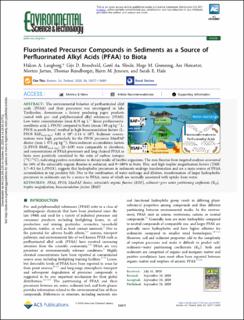Fluorinated Precursor Compounds in Sediments as a Source of Perfluorinated Alkyl Acids (PFAA) to Biota
Langberg, Håkon Austad; Breedveld, Gijs D.; Slinde, Gøril Aasen; Grønning, Hege Mentzoni; Høisæter, Åse; Jartun, Morten; Rundberget, Thomas; Jenssen, Bjørn Munro; Hale, Sarah
Peer reviewed, Journal article
Published version
Date
2020Metadata
Show full item recordCollections
- NGI articles [1026]
Original version
Environmental Science and Technology. 2020, 54 (20), 13077-13089. 10.1021/acs.est.0c04587Abstract
The environmental behavior of perfluorinated alkyl acids (PFAA) and their precursors was investigated in lake Tyrifjorden, downstream a factory producing paper products coated with per- and polyfluorinated alkyl substances (PFAS). Low water concentrations (max 0.18 ng L–1 linear perfluorooctanesulfonic acid, L-PFOS) compared to biota (mean 149 μg kg–1 L-PFOS in perch livers) resulted in high bioaccumulation factors (L-PFOS BAFPerch liver: 8.05 × 105–5.14 × 106). Sediment concentrations were high, particularly for the PFOS precursor SAmPAP diester (max 1 872 μg kg–1). Biota-sediment accumulation factors (L-PFOS BSAFPerch liver: 22–559) were comparable to elsewhere, and concentrations of PFAA precursors and long chained PFAA in biota were positively correlated to the ratio of carbon isotopes (13C/12C), indicating positive correlations to dietary intake of benthic organisms. The sum fluorine from targeted analyses accounted for 54% of the extractable organic fluorine in sediment, and 9–108% in biota. This, and high trophic magnification factors (TMF, 3.7–9.3 for L-PFOS), suggests that hydrophobic precursors in sediments undergo transformation and are a main source of PFAA accumulation in top predator fish. Due to the combination of water exchange and dilution, transformation of larger hydrophobic precursors in sediments can be a source to PFAA, some of which are normally associated with uptake from water.
